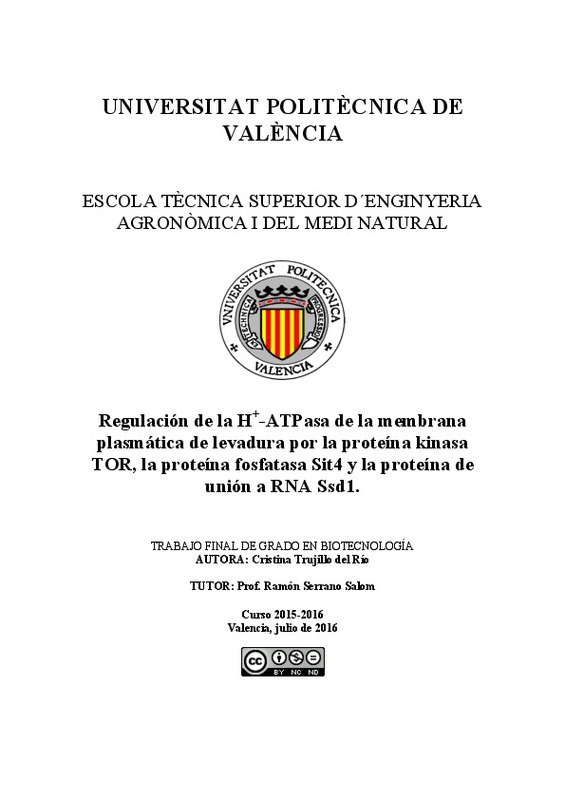|
[ES] La H+-ATPasa de la membrana plasmática de la levadura Saccharomyces cerevisiae (Pma1) regula el crecimiento celular por energizar la entrada de nutrientes y por modular el pH intracelular y extracelular. Los principales ...[+]
[ES] La H+-ATPasa de la membrana plasmática de la levadura Saccharomyces cerevisiae (Pma1) regula el crecimiento celular por energizar la entrada de nutrientes y por modular el pH intracelular y extracelular. Los principales factores ambientales que regulan su actividad son la fuente de carbono (glucosa que es fermentable e induce crecimiento rápido activa más que etanol que es respirable e induce crecimiento lento) y el pH del medio (pH ácido externo activa). La activación va unida a doble fosforilación de Ser911 Thr912 en el dominio inhibidor carboxi-terminal de la enzima pero se desconocen las kinasas y fosfatasas involucradas. En este proyecto se utilizará un método de filtración rápida de los cultivos seguida de inmersión de las células en nitrógeno líquido para preservar el estado fisiológico de Pma1. Se investigará el efecto de rapamycin (inhibidor de TOR), de temperatura no permisiva en un mutante termosensible de TOR, de un mutante en Tco89 (una subunidad de TOR) y en mutantes en dos proteínas esenciales redundantes, la proteína fosfatasa Sit4 y la proteína de unión a RNA Ssd1. Está última ha sido relacionada recientemente con tolerancia a acidificación intracelular. Todas estas proteínas tienen en común el promover el crecimiento celular, probablemente a través de aumentar el pH intracelular y estos estudios sirven de modelo para el papel del pH intracelular en el crecimiento rápido de las celular tumorales.
[-]
[EN] Yeast plasma membrane H+-ATPasa (Pma1) regulates cell growth by energizing nutrient uptake and modulating intracellular pH (together with potassium transport). Main factors regulating Pma1 are carbon source (glucose ...[+]
[EN] Yeast plasma membrane H+-ATPasa (Pma1) regulates cell growth by energizing nutrient uptake and modulating intracellular pH (together with potassium transport). Main factors regulating Pma1 are carbon source (glucose activates and induces fast growth and fermentative metabolism) and external acid pH. Activation of PMa1 correlates with double phosphorylation of Ser-9141 and Thr-912 within the inhibitory carboxy-terminal domain of the enzyme. The nature of the protein kinases and phosphorylation sites such as Ser507 are not known. This project has investigated the activity of Pma1 in strains with null mutations in the genes SSD1, SIT4 and TCO89. The RNA-binding protein Ssd1 has been identified as a positive factor for cell growth and for tolerance to intracellular acidification and it exhibits synthetic lethality with protein phosphate Sit4. Tco89 is a subunit of protein kinase TORC1, a master regulator of growth that is hyper-activated in cancer cells. The role of TORC1 in Pma1 activity has been investigated with the specific inhibitor rapamycin and with the effect of non-permisive temperature in a thermosensitive mutant of TOR. All these regulatory proteins have in common to promote cell growth and division, probably by increasing intracellular pH by activating PMa1 and potassium transport (Sit4 and TORC1). They could also reinforce cellular systems inhibited by intracellular acidification. Our results suggest that there is a regulation of the H+-ATPasa of the plasma membrane by TOR and protein phosphatase Sit 4. These studies with the yeast system serve as a model for the homeostasis of intracellular pH during the fast growth of tumor cells.
[-]
|







